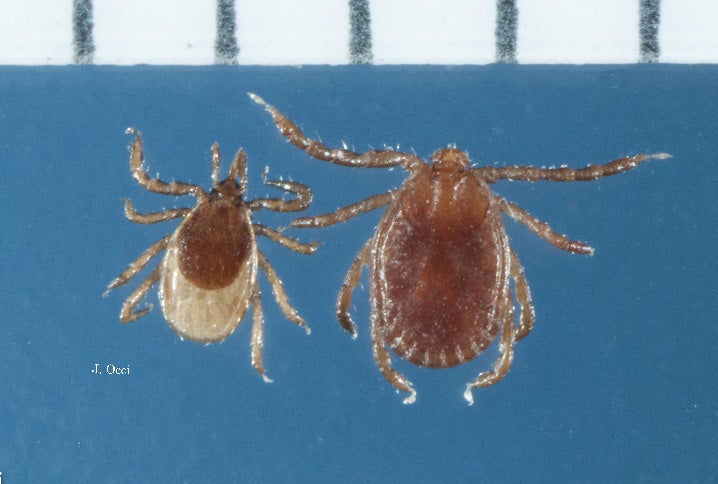Immaculate Conception in TICKS? Can those suckers really do that? Think back to high school biology when you learned about reproduction. You probably best remember sexual reproduction, and not just because it had to do with sex. This is the type of reproduction we think of as most common, mainly because it’s how most animals make more of themselves. It’s actually how a lot of plants reproduce, too.
But other types of organisms, like bacteria, copy themselves through asexual reproduction (meaning, simply, without sex). In a particularly rare case of this evolutionary adaptation, called parthenogenesis [PAR-theno-GEN-e-sis], a female animal can produce offspring without getting anything from a male (sorry, guys). Her eggs develop either as clones of her or by genetic material mixing up within each egg to produce half clones.
Some salamanders and geckos only reproduce asexually, a strategy known as obligate parthenogenesis. Others can reproduce sexually or without males as the situation requires – otherwise known as facultative parthenogenesis. This generally happens when environmental conditions necessitate it, like when there is an absence of males or certain seasons require quick population increases. Many ray and shark species including zebra, hammerhead, spotted eagle ray can switch to parthenogenesis (Dudgeon et al. 2017), but females of some snake species, like the rainbow boa, have been known to choose to have litters on their own, even when males are available (Booth et al. 2011).

This phenomenon is actually better known among invertebrates, including several species of ticks. Amblyomma rotundatum, a tick that feeds on cold-blooded animals in Brazil, was the first tick to be described as displaying obligate parthenogenesis back in 1912 (Aragao 1912). Since then, facultative parthenogenesis has been observed in several other tick species including the cattle tick (Boophilus microplus) (Stone 1963), the American dog tick (Dermacentor variabilis) (Gladney & Dawkins 1971), and the rabbit tick (Haemaphysalis leporis-palustris) (Labruna & Leite 1997).
Late last year (2017), sex-less tick reproduction made headlines when the owner of a farm in Hunterdon County, NJ reported a massive tick infestation on her one and only pet Icelandic sheep living on the property (Tadhgh et al. 2018). The sheep had never traveled, living its entire 12 years on the small farm. When researchers from the Department of Health and the Center for Vector Biology at Rutgers University arrived to investigate, they found a paddock that was literally crawling with ticks. They collected samples, examined them under a microscope, and performed DNA tests for confirmation. After much consultation, the experts concluded that they had encountered bush ticks (Haemaphysalis longicornis), an exotic species native to Asia, New Zealand, and Australia that has never been reported in the U.S. beyond a single import or two. The researchers found all three life stages, larvae, nymphs, and adults on the sheep while mostly larvae were found on the ground.
However, a bit of a mystery remains. Of hundreds of ticks removed from the sheep, only a single male was discovered. The bush tick is known to have both sexually-reproducing and parthenogenic populations within their native range, so it’s possible that this infestation is the parthenogenic variety. Further study will be ongoing to figure out which type of bush tick this is, as well as monitoring to ensure that this tick has not traveled further than the paddock. When researchers returned after the sheep and the area were treated with permethrin, no additional ticks were found but teams of researchers will be back scouring the region looking this spring and summer. While it’s unlikely for a local population to have been established, only time will tell whether the ticks hunkered down for the winter in the leaf litter and will reemerge come springtime.
References
Booth W, Million LR, Reynolds RG, Burghardt GM, Vargo EL, Schal C, Tizka AC, Schuett GW. Consecutive virgin births in the new world boid snake, the Colombian rainbow Boa, Epicrates maurus. Journal of Heredity. 102: 759–763.
Dudgeon CL, Coulton L, Bone R, Ovenden JR, Thomas S. 2017. Switch from sexual to parthenogenetic reproduction in a zebra shark. Nature: Scientific Reports. 7:40537.
Gladney WJ, Dawkins C. 1971. Parthenogenetic reproduction by Dermacentor variabilis (Acarina: Ixodidae). Annals of the Entomological Society of America. 64: 1285-1289.
Labruna MB, Leite RC. 1997. Reproductive aspects of Haemaphysalis leporispalustris. Mem Inst Oswaldo Cruz. 92: 373- 376.
Stone BF. 1963. Pathenogenesis in the cattle tick, Boophilus microplus. Nature. 200: 1233.
Tadhgh R, Occi JL, Robbins RG, Egizi A. 2018. Discovery of Haemaphysalis longicornis (Ixodida: Ixodidae) parasitizing a sheep in New Jersey< United States. Journal of Medical Entomology. tjy006. https://doi.org/10.1093/jme/tjy006.

Heather Kopsco was a Ph.D candidate and helped coordinate TickEncounter’s outreach program from 2016-2020. Currently, she is a post-doctoral fellow at the University of Illinois.
